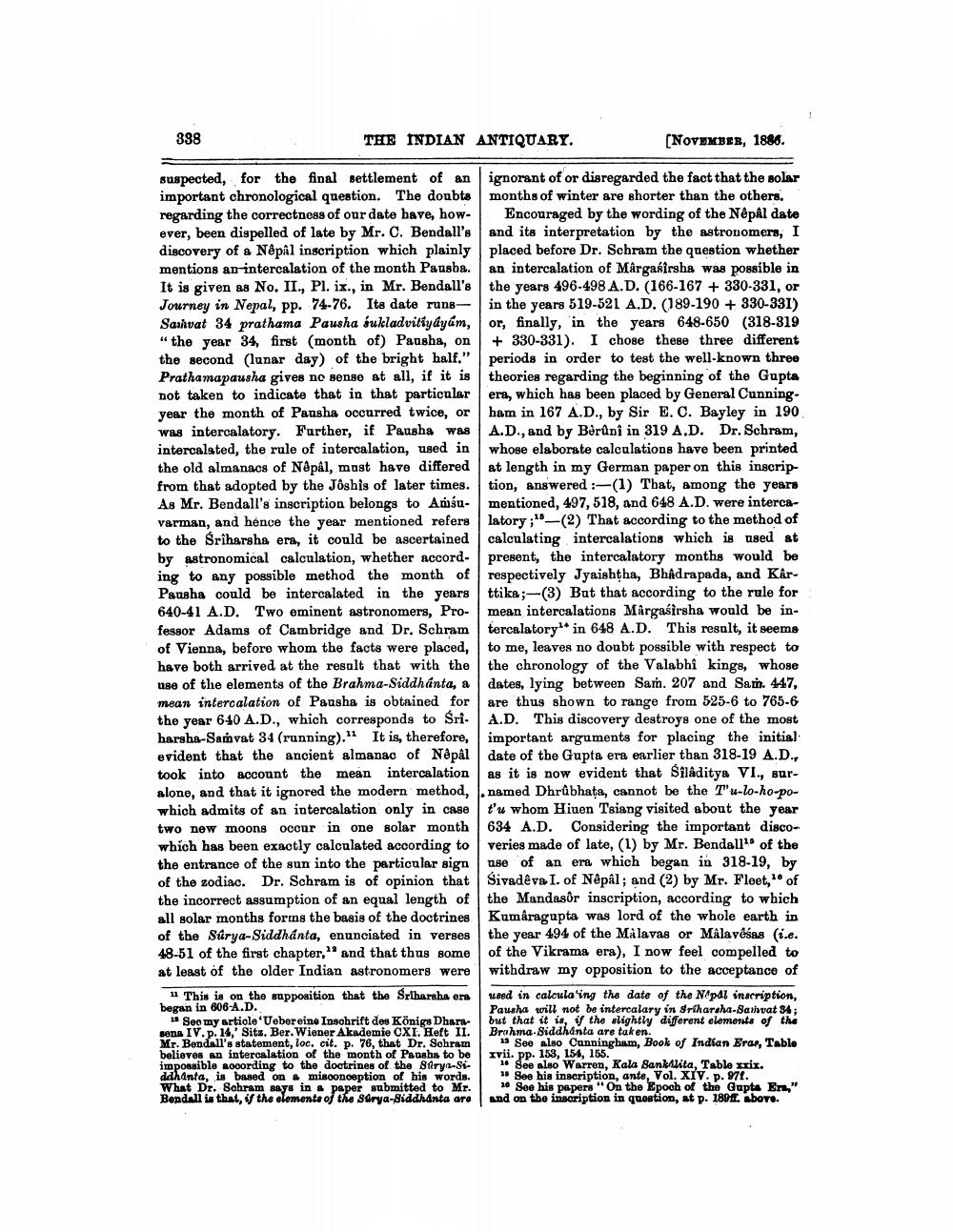________________
338
THE INDIAN ANTIQUARY.
suspected, for the final settlement of an important chronological question. The doubts regarding the correctness of our date have, however, been dispelled of late by Mr. C. Bendall's discovery of a Népal inscription which plainly mentions an intercalation of the month Pausba. It is given as No. II., Pl. ix., in Mr. Bendall's Journey in Nepal, pp. 74-76. Its date runs Samvat 34 prathama Pausha sukladvitiyayam, "the year 34, first (month of) Pausha, on the second (lunar day) of the bright half." Prathamapausha gives no sense at all, if it is not taken to indicate that in that particular year the month of Pausha occurred twice, or was intercalatory. Further, if Pausha was intercalated, the rule of intercalation, used in the old almanacs of Nêpål, must have differed from that adopted by the Jôshis of later times. As Mr. Bendall's inscription belongs to Amsuvarman, and hence the year mentioned refers to the Sriharsha era, it could be ascertained by astronomical calculation, whether according to any possible method the month of Pausha could be intercalated in the years 640-41 A.D. Two eminent astronomers, Professor Adams of Cambridge and Dr. Schram of Vienna, before whom the facts were placed, have both arrived at the result that with the use of the elements of the Brahma-Siddhanta, a mean intercalation of Pausha is obtained for the year 640 A.D., which corresponds to Śrîharsha-Samvat 34 (running)." It is, therefore, evident that the ancient almanac of Nêpâl took into account the mean intercalation alone, and that it ignored the modern method,. which admits of an intercalation only in case two new moons occur in one solar month which has been exactly calculated according to the entrance of the sun into the particular sign of the zodiac. Dr. Schram is of opinion that the incorrect assumption of an equal length of all solar months forms the basis of the doctrines of the Surya-Siddhanta, enunciated in verses 48-51 of the first chapter," and that thus some at least of the older Indian astronomers were
This is on the supposition that the Śriharsha era began in 606-A.D.
See my article 'Ueber eine Inschrift des Königs Dhara sena IV. p. 14,' Sitz. Ber. Wiener Akademie CXI. Heft II. Mr. Bendall's statement, loc. cit. p. 76, that Dr. Schram believes an intercalation of the month of Pausha to be impossible according to the doctrines of the Surya-Siddhanta, is based on a misconception of his words. What Dr. Schram says in a paper submitted to Mr. Bendall is that, if the elements of the Surya-Siddhanta are
[NOVEMBER, 1886.
ignorant of or disregarded the fact that the solar months of winter are shorter than the others.
Encouraged by the wording of the Nêpâl date and its interpretation by the astronomers, I placed before Dr. Schram the question whether an intercalation of Mârgasirsha was possible in the years 496-498 A.D. (166-167+ 330-331, or in the years 519-521 A.D. (189-190+330-331) or, finally, in the years 648-650 (318-319 + 330-331). I chose these three different periods in order to test the well-known three theories regarding the beginning of the Gupta era, which has been placed by General Cunningham in 167 A.D., by Sir E. C. Bayley in 190. A.D., and by Berûnî in 319 A.D. Dr. Schram, whose elaborate calculations have been printed at length in my German paper on this inscription, answered :-(1) That, among the years mentioned, 497, 518, and 648 A.D. were intercalatory ;-(2) That according to the method of calculating intercalations which is used at present, the intercalatory months would be respectively Jyaishṭha, Bhadrapada, and Kârttika;-(3) But that according to the rule for mean intercalations Margaśirsha would be intercalatory in 648 A.D. This result, it seems to me, leaves no doubt possible with respect to the chronology of the Valabhî kings, whose dates, lying between Sam. 207 and Sam. 447, are thus shown to range from 525-6 to 765-6 A.D. This discovery destroys one of the most important arguments for placing the initial date of the Gupta era earlier than 318-19 A.D., as it is now evident that Silâditya VI., surnamed Dhrûbhața, cannot be the T'u-lo-ho-pot'u whom Hiuen Tsiang visited about the year 634 A.D. Considering the important discoveries made of late, (1) by Mr. Bendall's of the use of an era which began in 318-19, by Sivadêva I. of Nêpâl; and (2) by Mr. Fleet, 1° of the Mandasôr inscription, according to which Kumâragupta was lord of the whole earth in the year 494 of the Malavas or Mâlavesas (i.e. of the Vikrama era), I now feel compelled to withdraw my opposition to the acceptance of
used in calculating the date of the Nepal inscription, Pausha will not be intercalary in Sriharsha-Samvat 34; but that it is, if the slightly different elements of the Brahma Siddhanta are taken.
15 See also Cunningham, Book of Indian Eras, Table xvii. pp. 153, 154, 155.
1 See also Warren, Kala Sankalita, Table xxix. 15 See his inscription, ante, Vol. XIV. p. 971.
16 See his papers "On the Epoch of the Gupta Era," and on the inscription in question, at p. 189ff. above.




